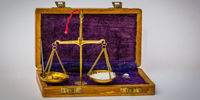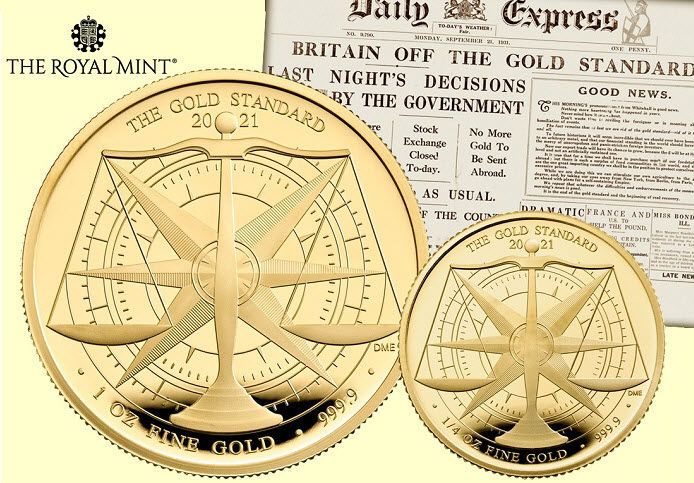Posted on February 03, 2022

By Paul Vanguard, for BullionMax.com
We know about the gold standard, or at least we think we do. We'd mostly like to return to it. The idea of “money” as having intrinsic value, having its own utility beyond simply paying for stuff, has a lot going for it. Especially today, when we’re seeing 7% year-over-year price hikes across the board.
The best-ever argument we’ve ever seen for returning to the gold standard comes from William J. Luther and Alexander William Salter’s op-ed from The Wall Street Journal:
Inflation averaged only 0.2% a year from 1790 to 1913, when the Federal Reserve Act passed. Inflation was higher under the Fed-managed gold standard, averaging 2.7% from 1914 to 1971. It has been even higher without the constraint of gold. From 1972 to 2019, inflation averaged 4%.
Or Michael D. Bordo’s influential paper on the gold standard:
Between 1880 and 1914, the period when the United States was on the “classical gold standard,” inflation averaged only 0.1 percent per year.
Did you ever wonder exactly where the idea of the gold standard came from? We did (not coincidentally, we just received shipments of a new coin from The Royal Mint that sparked our curiosity).
So today, a brief introduction to the father of the gold standard, and a new product announcement.
Onward!
Pretty much throughout human history up to the 18th century, gold and silver were used as common methods of payment. Everything from Florence’s famed florins, Spanish doubloons, Dutch thalers (that’s where we get our word “dollar”) and even English pennies were minted in gold, silver or some combination of the two.
That’s all well and good. Except for one thing (a challenge facing even modern mints): How do you know the future value of a coin’s gold or silver content? Consider: When you mint a brand new gold coin and engrave a face value on it, the instant the coin’s intrinsic (or melt) value exceeds its face value, sharp citizens are going to immediately buy them all up, melt them down, sell the precious metals and pocket the difference. This is a basic tenet of finance we call Gresham’s Law, defined in 1558 but so obvious it was a truism as far back as 405 BCE. (See the Coinage Act of 1965 for a specific example.)
Remember Isaac Newton, the gravity guy? Well, in 1712, he was the top dog at The Royal Mint of England. One day he made a mathematical error which undervalued silver compared to gold in relation to Britain's coinage. Exactly as you’d expect, people used gold coins to buy the same face value of silver coins, just like Gresham’s Law says. Virtually every silver coin in the nation vanished, and a suspicious number of still-warm silver bullion bars sailed out of Britain for overseas ports where silver was valued more highly. Newton found himself Master of the Mint in a nation with virtually no silver coins and too much gold. He declared, “gold in England is overvalued in proportion to silver … and this excess value tends to increase the gold coins and diminish the silver coins of this kingdom.”
Yes, that sounds like a good problem to have. We’d all rather have more gold than silver. But think about it for a minute… Silver coins were the small change of the time (farthings, halfpennies, pennies, shillings and crowns). Everyday folks never saw a gold coin. Take-home pay for unskilled laborers was about 7 pennies a day. Silver coins were what people used for everyday purchases, for things like food and beer and to pay taxes. So running out of silver coins was a major problem for the nation. Everyday commerce all but ground to a halt. (Thought experiment: imagine you’re running a corner gas station, then one day everybody tries to pay you with $100 bills and you can’t make change…)
Newton was smart enough to make sure this sort of oopsie wasn't repeated. How? He invented the first informal gold standard: mint a gold coin (the sovereign) and give it a face value in silver (£1, or 1 pound sterling, or one lb of refined silver). Boom! Problem solved, gold and silver are officially interchangeable at face value. Now, this system breaks down if ne’er-do-wells clip or shave coins to reduce their precious metal contents. So Newton turned his attention to catching and convicting, even executing, counterfeiters or coin debasers. He also improved The Royal Mint’s procedures accurately assaying the gold and silver contents of the coins they issued.
English coinage became the de facto international medium of exchange, and English coins were in demand worldwide. The United Kingdom enjoyed its time as the world’s global reserve currency from the early 1800s until 1931, when the double-whammy of recovering from World War I and the Great Depression forced the UK off the gold standard entirely.
In the words of President Hoover: "We have gold because we cannot trust governments."
Or, as Ron Paul tells us, “Ronald Reagan once told me that no nation has abandoned gold and remained great.”
The period between 1873 and the first World War is generally seen as an internationally prosperous time, a global golden age of technological growth and commerce. Then came World War I, which bankrupted Europe. In an interesting twist on Gresham’s Law, entire nations gave up on minting gold coins. They issued paper money instead, meanwhile melting down their own coinage and shipping bullion bars overseas to buy food and weapons. (You’ll note none of the 20 franc gold coins we offer are dated post-1914.)
World War I ended gold coinage. World War II was even worse, economically, politically and in terms of sheer carnage. Some nations flirted with returning to gold standards afterward. The U.S. did, until the bill for the Vietnam War came due. There wasn't enough real money to pay for it.
Just like we credit Newton with inventing the gold standard, we credit Nixon with inventing money printing and its side effect, the pernicious destruction of the dollar’s buying power.

The Royal Mint launched a commemorative "Gold Standard" series of gold coins in 2016, two centuries after the introduction of their gold sovereign. We're now witnessing the sixth minting of two of the most popular coins in the series, a one ounce gold coin and a 1/4 ounce gold bullion coin. Both share 0.9999 pure gold content. Sir Isaac would be proud! Want to buy gold bullion? Take a look at these fantastic coins.
As with the rest of the series, the coin's reverse design by master engraver Dominique Evans shows an old-school balance scale superimposed over a compass rose. A nod to Newton's slip-up, perhaps? And a reminder that a nation's money should be placed in the hands of its people no less than in those who presume to govern it.
Paul Vanguard is a lifelong precious metals enthusiast and a proud member of the BullionMax team.